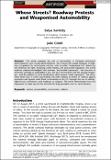Files in this item
Whose streets? : Roadway protests and weaponised automobility
Item metadata
| dc.contributor.author | Savitzky, Satya | |
| dc.contributor.author | Cidell, Julie | |
| dc.date.accessioned | 2022-03-18T10:30:07Z | |
| dc.date.available | 2022-03-18T10:30:07Z | |
| dc.date.issued | 2023-08-01 | |
| dc.identifier | 277787356 | |
| dc.identifier | ccf32f00-a341-4a58-a270-3a8c3aa520aa | |
| dc.identifier | 85126385290 | |
| dc.identifier | 000770105700001 | |
| dc.identifier.citation | Savitzky , S & Cidell , J 2023 , ' Whose streets? Roadway protests and weaponised automobility ' , Antipode , vol. 55 , no. 5 , pp. 1479-1495 . https://doi.org/10.1111/anti.12818 | en |
| dc.identifier.issn | 0066-4812 | |
| dc.identifier.uri | https://hdl.handle.net/10023/25065 | |
| dc.description.abstract | The article examines the role of automobility in US-based anti-racism demonstrations and counter-demonstrations. We contrast the spatial strategies of highway occupations by racial justice activists, with so-called “weaponised car” attacks by the American far right. Analysing online memes and anti-protest legislation, the article explores under-acknowledged links between “automobile supremacy”—the structure of motorists' privilege as embedded in law, the built environment and the popular imaginary—and the patterns of racial stratification often termed “white supremacy”. We document three ways in which automobility has been enlisted as means of violence against protestors and against wider Black communities in the US: through the use of vehicles, right-of-way conventions, and roadways as weapons. The article demonstrates how the imperative to make way for the motorist has long provided cover for racial injustice. | |
| dc.format.extent | 17 | |
| dc.format.extent | 376270 | |
| dc.language.iso | eng | |
| dc.relation.ispartof | Antipode | en |
| dc.subject | Protests | en |
| dc.subject | Automobiles | en |
| dc.subject | Racial justice | en |
| dc.subject | Violence | en |
| dc.subject | HN Social history and conditions. Social problems. Social reform | en |
| dc.subject | 3rd-DAS | en |
| dc.subject | SDG 16 - Peace, Justice and Strong Institutions | en |
| dc.subject | MCC | en |
| dc.subject.lcc | HN | en |
| dc.title | Whose streets? : Roadway protests and weaponised automobility | en |
| dc.type | Journal article | en |
| dc.contributor.institution | University of St Andrews. School of International Relations | en |
| dc.identifier.doi | https://doi.org/10.1111/anti.12818 | |
| dc.description.status | Peer reviewed | en |
This item appears in the following Collection(s)
Items in the St Andrews Research Repository are protected by copyright, with all rights reserved, unless otherwise indicated.

